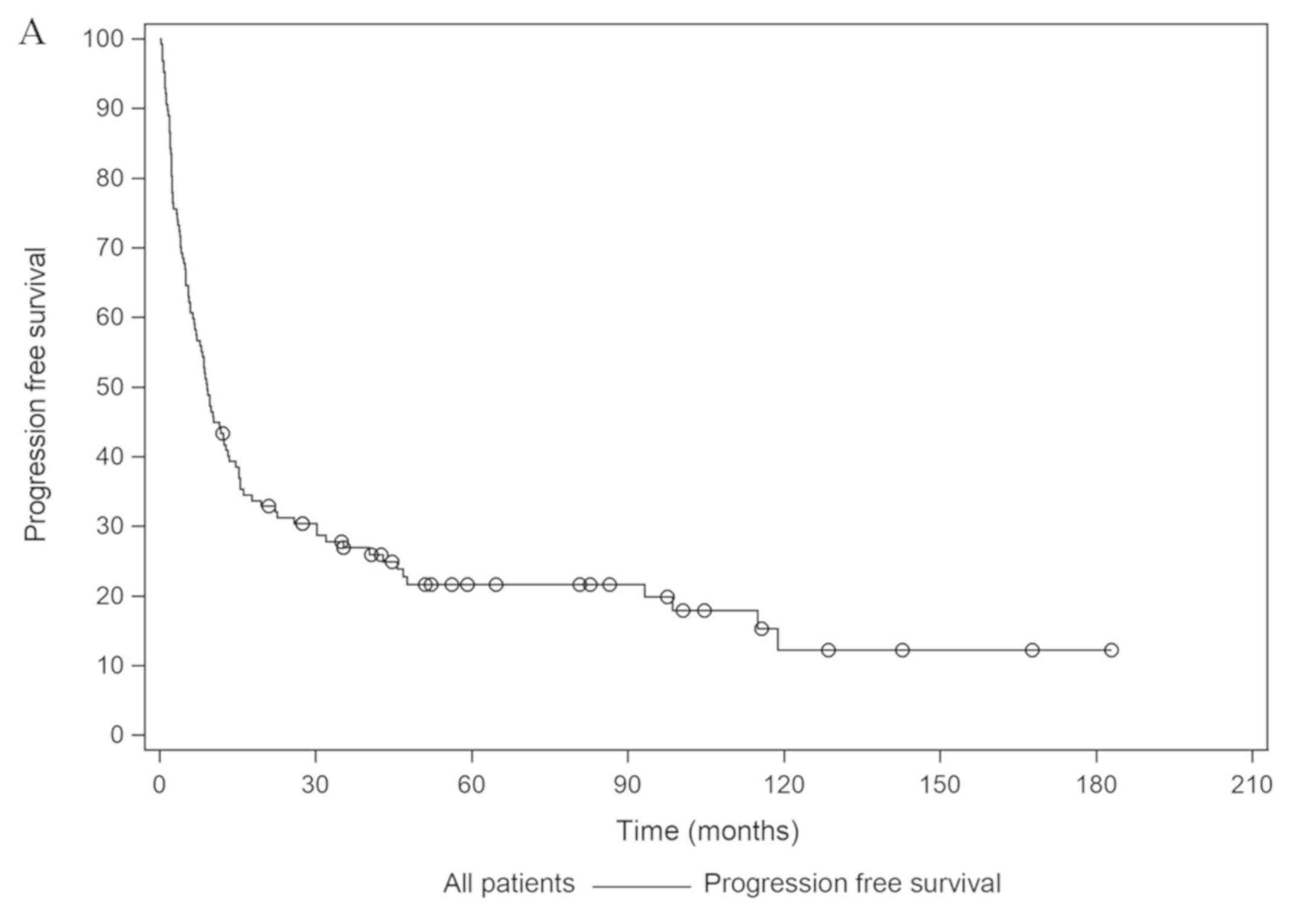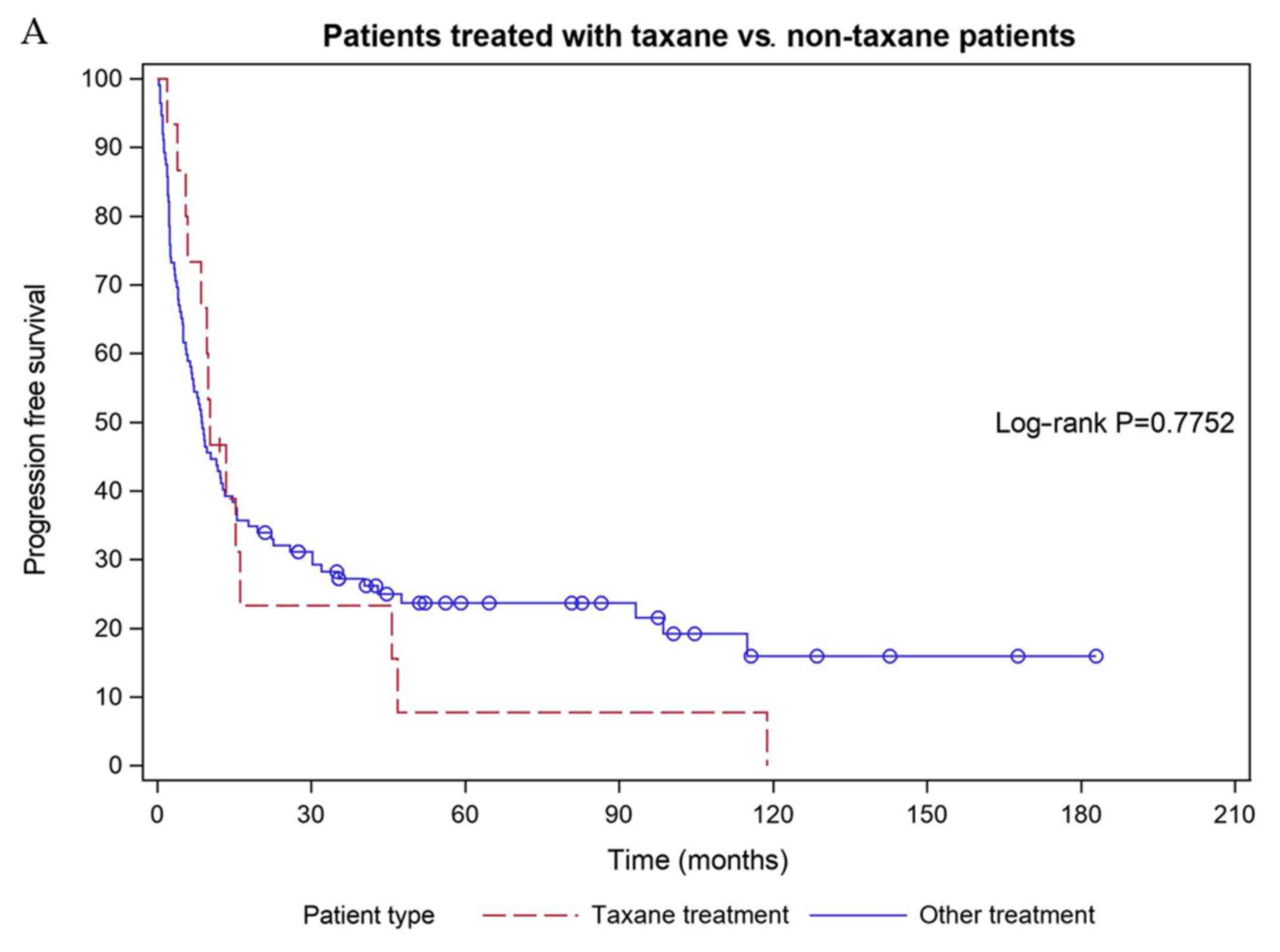|
1
|
Linch M, Miah AB, Thway K, Judson IR and
Benson C: Systemic treatment of soft-tissue sarcoma-gold standard
and novel therapies. Nat Rev Clin Oncol. 11:187–202.
2014.PubMed/NCBI View Article : Google Scholar
|
|
2
|
Young RJ, Brown NJ, Reed MW, Hughes D and
Woll PJ: Angiosarcoma. Lancet Oncol. 11:983–991. 2010.PubMed/NCBI View Article : Google Scholar
|
|
3
|
Penel N, Bui BN, Bay J-O, Cupissol D,
Ray-Coquard I, Piperno-Neumann S, Kerbrat P, Fournier C, Taieb S,
Jimenez M, et al: Phase II trial of weekly paclitaxel for
unresectable angiosarcoma: The ANGIOTAX Study. J Clin Oncol.
26:5269–5274. 2008.PubMed/NCBI View Article : Google Scholar
|
|
4
|
Schlemmer M, Reichardt P, Verweij J,
Hartmann J, Judson I, Thyss A, Hogendoorn PC, Marreaud S, Van
Glabbeke M and Blay JY: Paclitaxel in patients with advanced
angiosarcomas of soft tissue: A retrospective study of the EORTC
soft tissue and bone sarcoma group. Eur J Cancer. 44:2433–2436.
2008.PubMed/NCBI View Article : Google Scholar
|
|
5
|
Italiano A, Cioffi A, Penel N, Levra MG,
Delcambre C, Kalbacher E, Chevreau C, Bertucci F, Isambert N, Blay
JY, et al: Comparison of doxorubicin and weekly paclitaxel efficacy
in metastatic angiosarcomas. Cancer. 118:3330–3336. 2012.PubMed/NCBI View Article : Google Scholar
|
|
6
|
Buehler D, Rice SR, Moody JS, Rush P,
Hafez GR, Attia S, Longley BJ and Kozak KR: Angiosarcoma outcomes
and prognostic factors: A 25-year single institution experience. Am
J Clin Oncol. 37(473)2014.PubMed/NCBI View Article : Google Scholar
|
|
7
|
Penel N, Italiano A, Ray-Coquard I,
Chaigneau L, Delcambre C, Robin YM, Bui B, Bertucci F, Isambert N,
Cupissol D, et al: Metastatic angiosarcomas: Doxorubicin-based
regimens, weekly paclitaxel and metastasectomy significantly
improve the outcome. Ann Oncol. 23:517–523. 2011.PubMed/NCBI View Article : Google Scholar
|
|
8
|
Fury MG, Antonescu CR, Van Zee KJ, Brennan
ME and Maki RG: A 14-year retrospective review of angiosarcoma:
Clinical characteristics, prognostic factors, and treatment
outcomes with surgery and chemotherapy. Cancer J. 11:241–247.
2005.PubMed/NCBI View Article : Google Scholar
|
|
9
|
Skubitz KM and Haddad PA: Paclitaxel and
pegylated-liposomal doxorubicin are both active in angiosarcoma.
Cancer. 104:361–366. 2005.PubMed/NCBI View Article : Google Scholar
|
|
10
|
Pawlik TM, Paulino AF, Mcginn CJ, Baker
LH, Cohen DS, Morris JS, Rees R and Sondak VK: Cutaneous
angiosarcoma of the scalp: A multidisciplinary approach. Cancer.
98:1716–1726. 2003.PubMed/NCBI View Article : Google Scholar
|
|
11
|
Abraham JA, Hornicek FJ, Kaufman AM,
Harmon DC, Springfield DS, Raskin KA, Mankin HJ, Kirsch DG,
Rosenberg AE, Nielsen GP, et al: Treatment and outcome of 82
patients with angiosarcoma. Ann Surg Oncol. 14:1953–1967.
2007.PubMed/NCBI View Article : Google Scholar
|
|
12
|
Sher T, Hennessy BT, Valero V, Broglio K,
Woodward WA, Trent J, Hunt KK, Hortobagyi GN and Gonzalez-Angulo
AM: Primary angiosarcomas of the breast. Cancer. 110:173–178.
2007.PubMed/NCBI View Article : Google Scholar
|
|
13
|
Mark RJ, Poen JC, Tran LM, Fu YS and
Juillard GF: Angiosarcoma: A report of 67 patients and a review of
the literature. Cancer. 77:2400–2406. 1996.PubMed/NCBI View Article : Google Scholar
|
|
14
|
Weidema ME, Flucke UE, van der Graaf WTA,
Ho VKY and Hillebrandt-Roeffen MHS: Dutch Nationwide Network and
Registry of Histo- and Cytopathology (PALGA)-Group,
Versleijen-Jonkers YMH, Husson O and Desar IME. Prognostic factors
in a large nationwide cohort of histologically confirmed primary
and secondary angiosarcomas. Cancers (Basel).
11(E1780)2019.PubMed/NCBI View Article : Google Scholar
|
|
15
|
Bonvalot S, Rivoire M, Castaing M,
Stoeckle E, Le Cesne A, Blay JY and Laplanche A: Primary
retroperitoneal sarcomas: A multivariate analysis of surgical
factors associated with local control. J Clin Oncol. 27:31–37.
2009.PubMed/NCBI View Article : Google Scholar
|
|
16
|
Le Cesne A, Ouali M, Leahy MG, Santoro A,
Hoekstra H, Hohenberger P, Van Coevorden F, Rutkowski P, Van Hoesel
R, Verweij J, et al: Doxorubicin-based adjuvant chemotherapy in
soft tissue sarcoma: Pooled analysis of two STBSG-EORTC phase III
clinical trials. Ann Oncol. 25:2425–2432. 2014.PubMed/NCBI View Article : Google Scholar
|
|
17
|
Gronchi A, Vullo SL, Colombo C, Collini P,
Stacchiotti S, Mariani L, Fiore M and Casali PG: Extremity soft
tissue sarcoma in a series of patients treated at a single
institution: Local control directly impacts survival. Ann Surg.
251:506–511. 2010.PubMed/NCBI View Article : Google Scholar
|
|
18
|
Young R, Natukunda A, Litière S, Woll P,
Wardelmann E and Van Der Graaf W: First-line anthracycline-based
chemotherapy for angiosarcoma and other soft tissue sarcoma
subtypes: Pooled analysis of eleven European Organisation for
Research and Treatment of Cancer Soft Tissue and Bone Sarcoma Group
trials. Eur J Cancer. 50:3178–3186. 2014.PubMed/NCBI View Article : Google Scholar
|
|
19
|
Fata F, O'Reilly E, Ilson D, Pfister D,
Leffel D, Kelsen DP, Schwartz GK and Casper ES: Paclitaxel in the
treatment of patients with angiosarcoma of the scalp or face.
Cancer. 86:2034–2037. 1999.PubMed/NCBI
|
















